Language and Culture精品文档5页
- 格式:doc
- 大小:21.00 KB
- 文档页数:5

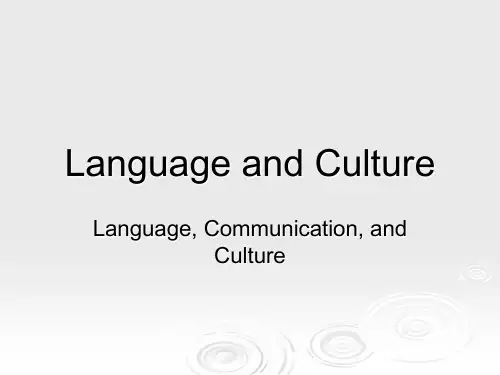
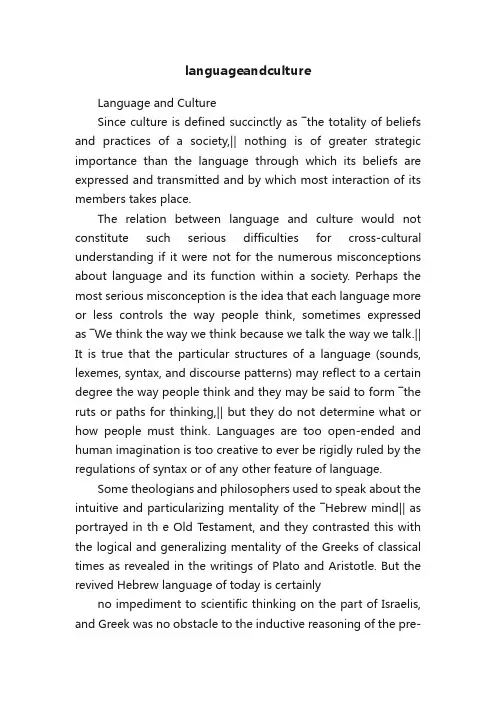
languageandcultureLanguage and CultureSince culture is defined succinctly as ―the totality of beliefs and practices of a society,‖ nothing is of greater strategic importance than the language through which its beliefs are expressed and transmitted and by which most interaction of its members takes place.The relation between language and culture would not constitute such serious difficulties for cross-cultural understanding if it were not for the numerous misconceptions about language and its function within a society. Perhaps the most serious misconception is the idea that each language more or less controls the way people think, sometimes expressed as ―We think the way we think because we talk the way we talk.‖ It is true that the particular structures of a language (sounds, lexemes, syntax, and discourse patterns) may reflect to a certain degree the way people think and they may be said to form ―the ruts or paths for thinking,‖ but th ey do not determine what or how people must think. Languages are too open-ended and human imagination is too creative to ever be rigidly ruled by the regulations of syntax or of any other feature of language.Some theologians and philosophers used to speak about the intuitive and particularizing mentality of the ―Hebrew mind‖ as portrayed in th e Old Testament, and they contrasted this with the logical and generalizing mentality of the Greeks of classical times as revealed in the writings of Plato and Aristotle. But the revived Hebrew language of today is certainlyno impediment to scientific thinking on the part of Israelis, and Greek was no obstacle to the inductive reasoning of the pre-Socratic philosophers nor did it later prevent Neoplatonists from usin g Greek to promote their philosophical ―flights of fantasy.‖Some people have thought that each language is so distinct that there is no valid way in which the discourses of one language can be translated into another. But at least ninety percent of the fundamental structures of all language are quite similar, and language universals far outweigh the divergencies. All languages employ figurative expressions, have poetry, use language in singing, and have a great number of literary forms or genres –from genealogies to prayers. One language-culture may emphasize the development and use of particular genres, e.g. epic poetry or animal folktales, which another language culture may seldom employ and may even strongly reject. But the people of any language-culture have sufficient imagination and experience to understand how the people of another language-culture may rightly differ in their behavior and values, since the behavioral differences within a single culture are usually greater than those which exist between cultures.The idea that some languages are far superior to other languages and that accordingly some cultures are far superior to other cultures is also a noted deterrent to understanding the relation between language and culture. When people speak about language superiority, they are usuallytalking about the literature which has been produced in such a language, or they evaluate the lexical and syntactic structures in terms of the ways these have been exploited by creative writers. The oral and written literatures of different languages can differ considerably in quality, but this is not the result of the formal structures of the language in question but of the ways in which the people of the society have invested creative talent in usingthe language as a medium for the production of valuable literary works. All languages have the potential for outstanding aesthetic expression. It is simply one of the ―accidents‖ of history which determines the emergence of literary genius.Some people, however, believe that some languages are fundamentally ugly, while others are intrinsically beautiful. In fact, most people insist that their own language belongs to the class of beautiful languages, even though it may have glottalized implosives, clicks that seem to pop and sputter, bilabial trills, and harsh guttural sounds. Phonological beauty is obviously in the ears of the hearer. Arabic, for example, is often cited as an acoustically unpleasant language in view of its various guttural consonants, but a number of Arab poets have succeeded in producing exquisite poems with rich sound patterns as acoustically sensuous and pleasing as occur in any language.A language does reflect in certain aspects the culture of a society, but primarily in its optional features, i.e. in certain of its hierarchies ofvocabulary and in the priorities given to various discourse patterns. It does not, however, reflect the culture in its phonology or syntax, which are largely fixed and arbitrary and must be such in order to function more or less automatically. Speakers are often conscious of the processes involved in the choice of words, and they are frequently well aware of the manner in which they organize a discourse, but they are almost totally unaware of the phonological system or the syntactic patterns which they employ.The hierarchies of vocabulary, that is, the ways in which terms representing classes of entities, activities, and characteristics are built up into taxonomies (both popular and scientific), reflect in large measure the manner in which people understand andclassify the world in which they live. Some form of the ―Twenty Questions Game‖ can be played in all languages, since people tend to divide up experience into classes or domains represented by sets of contrastive names, e.g. animate / inanimate, animal / vegetable / mineral, vertebrates / invertebrates, mammals / birds / fish / amphibians, canines / felines / bovines, shepherds / pointers / hounds / boxers.The formal features of lexemes are usually not as important as the taxonomic systems to which the lexemes belong. For example, the phrases morning star or evening star do not represent ―stars‖ but a planet (usually Venus), but in English we continue to use the terms althoughmost people are fully aware that the phrases are anomalies. Similarly, we speak of the sun as rising or setting, while in reality it is the earth which is moving. But there are cases in which a false classification has persisted for centuries with serious damage to proper understanding of a phenomenon. For example, the ancient Greeks placed pur―fire‖ in the class of substances rather than in the class of events, and this evidently encouraged a number of false ideas in alchemy about turning lead into gold by adding fire.The fact that a language may have a proportionately high number of terms in particular domains is an important index to the focus of a culture. For example, most languages of Western Europe have an exceptionally high percentage of technical terms, the Anuaks of the Sudan have hundreds of terms for different kinds and features of cattle, and the Quechuas of the Altiplano of Peru have scores of words for different kinds and forms of potatoes. The knowledge of certain terms is often an index to competence in a particular field of endeavor, and thedisappearance of terms from the vocabulary of a large segment of a society may indicate a significant change in the concerns of a culture. For example, it is increasingly difficult to find persons in the United States who are familiar with such terms as double-tree, hands high, to single-foot, jack, jenny, to gooseneck, withers, fetlock and fresno.Changes in culture often give rise to new types of discourse, e.g.technical prose, financial reports, and news resumes. Telegraphic style is giving way to the fuller statements employed in faxing, and commercial codes for cabling instructions to overseas agents are being dropped in favor of telephonic transfer of computer messages by means of modems.The popularity of certain types of discourse may also reflect cultural concerns. For example, lyric poetry is far more popular in Latin America than in the United States. And in general, epic poetry seems to have suffered a severe loss of popularity except in certain isolated regions, e.g. among the Nilotics of the Sudan and the speakers of some of the Dravidian languages of southern India.All of these interesting indices of the relation between language and culture are primarily matters of how language is used and are not matters of language structure. Since all languages are open systems, they have the potentiality for growth, change, and decline. In the hands of literary geniuses they can be the medium for brilliant aesthetic expression, and they can be seriously misused by persons who have little or no sensitivity for clarity or elegance.语言与文化——翻译中的语境(Eugene A. Nida)。

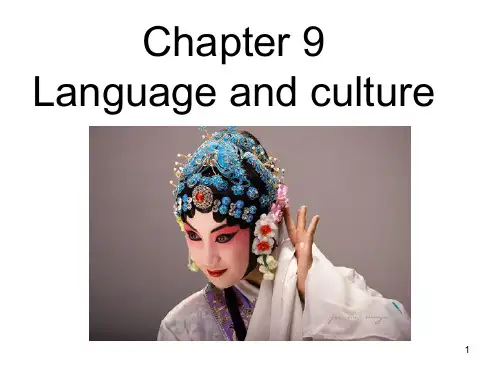
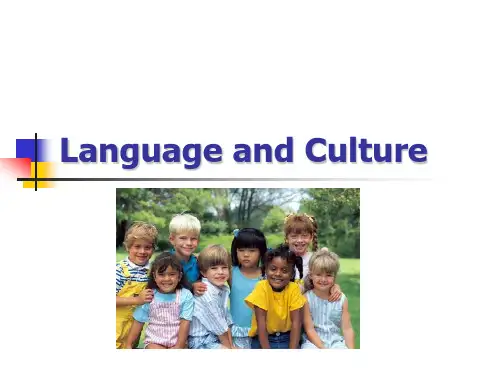
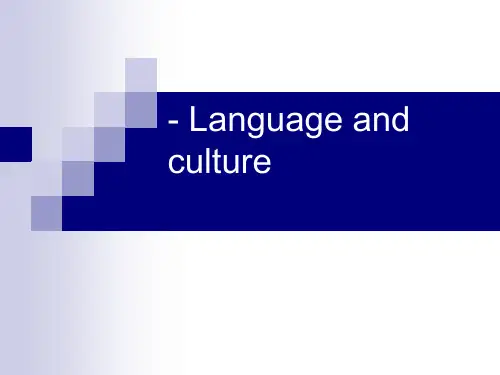
![Language and culture 介绍语言与文化的[优质ppt]](https://uimg.taocdn.com/4df561807f1922791788e842.webp)
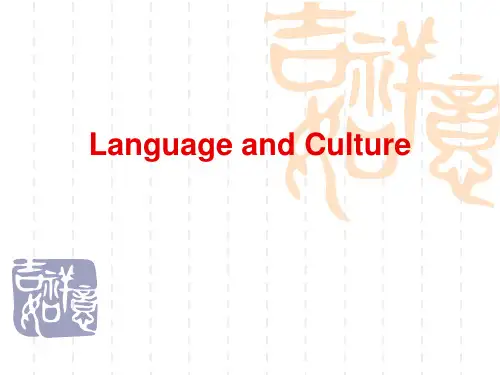
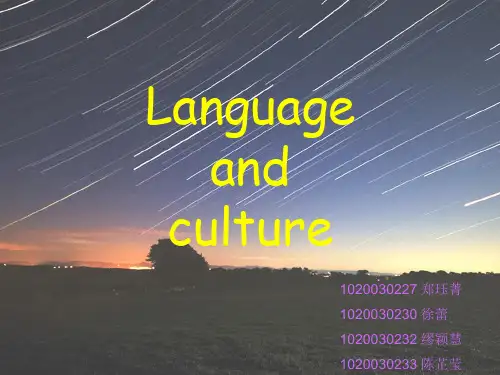
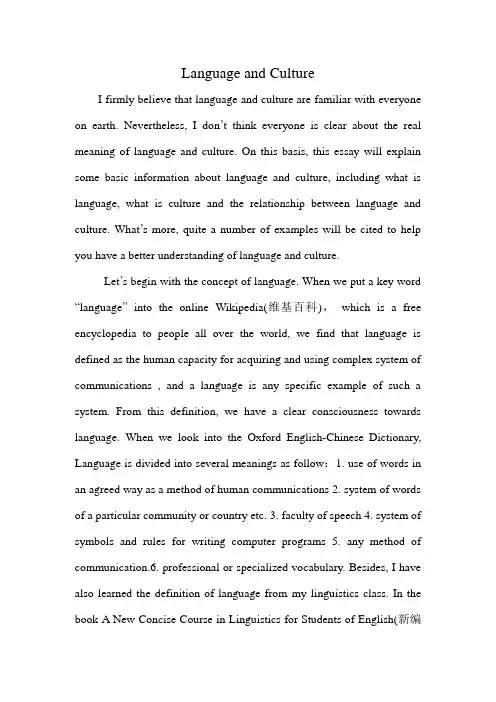
Language and CultureI firmly believe that language and culture are familiar with everyone on earth. Nevertheless, I don’t think everyone is clear about the real meaning of language and culture. On this basis, this essay will explain some basic information about language and culture, including what is language, what is culture and the relationship between language and culture. What’s more, quite a number of examples will be cited to help you have a better understanding of language and culture.Let’s begin with the concept of language. When we put a key word “language”into the online Wikipedia(维基百科),which is a free encyclopedia to people all over the world, we find that language is defined as the human capacity for acquiring and using complex system of communications , and a language is any specific example of such a system. From this definition, we have a clear consciousness towards language. When we look into the Oxford English-Chinese Dictionary, Language is divided into several meanings as follow:1. use of words in an agreed way as a method of human communications 2. system of words of a particular community or country etc. 3. faculty of speech 4. system of symbols and rules for writing computer programs 5. any method of communication.6. professional or specialized vocabulary. Besides, I have also learned the definition of language from my linguistics class. In the book A New Concise Course in Linguistics for Students of English(新编简明英语语言学教程). Langue is thought to be a system of arbitrary vocal symbol used for human communication. Short as it is, this definition has captured the main features of language. First of all, language is a system, that is, elements of language are combined according to rules. Second, language is arbitrary in the sense that theme is no intrinsic connection between a linguistic symbol and what the symbol stands for. This conventional nature of language is well illustrated by a famous quotation: A rose by any other name would smell as sweet. This quotation means rose is still rose even it is called by another name.For my part, the definition of language is varied. Generally speaking, it is a series code that facilitates human communication. And beyond a specific context, language has no intrinsic meaning.After finishing talking about what is language, let’s know more about culture. Similarly, in the Wikipedia, culture is defined as fallowing meanings, Firstly, culture is deemed as a modern concept based on a term first used in classical antiquity by the roman orator Cicero: Cultura animi ( cultiration of the soul). Secondly, the term “culture”in American anthropology had two meanings: the evolved human capacity to classify and represent experiences with symbol, and to act imaginatively and creatively. Thirdly, Hoebel describes culture as an integrated system of learned behavior patterns and which are not a result of biological inheritance. Besides, we learn the meaning of culture from theIntercultural Communication course. Culture is defined as the group of people who share the same ancestry. There are also many renowned socialists give culture several definitions. For example, E.sapir once said that culture may be defined as what a societu does and thinks.Shortly, culture is involved in so many aspects that it is hard to give it an accurate definition. Put in another way, for different people, culture has very different meaning, according to their own value, education background, social status and so forth. So there is nothing to criticize when other’s understanding of culture is different from yours.Having known so much basic information about language and culture, we will have look at the relationship between language and culture. In the book Intercultural communication in English(新编跨文化交际英语),there is a description of the relationship between language and culture. It goes like this: culture and language are intertwined and shape each other. Language is not a matter of neutral codes and grammatical rules. Each time we select words form sentences, and send a message, either oral or written. We also make cultural choices. We all agree that language helps in communication with people from different backgrounds. However, we may be less aware that cultural literary is necessary to understand the language being used. Personally speaking, language and culture is not two totally different subjects with no relevance. On the contrary, they are tightly related. That is to say, onlywhen language is put into a specific environment of cultural context does it have some real meaning.To have a better understanding of language and culture, several typical examples of the language and cultural difference between China and the western countries will be cited. We all know that the Chinese culture is both profound and extensive which leads to numerous idioms, allusions, proverbs and sayings, which is hard for foreigners to understand. Take some of them for instances. Firstly, take “过着牛郎织女的生活” for example, it can be literally translated as the Herd-boy and the spinning maid(mythical lovers separated by the Milky Way). But a foreigner may feel puzzled when look at this allusion, for they do not have the cultural background of the allusion. Actually, it is a folk tale of ancient China which means husband and wife living apart. If you want a foreigner fully understand this allusion, you’d better to tell him the whole tale, which also help him to know more about Chinese culture.There are also other four-character allusions in Chinese. Such as 三顾茅庐—make three calls at the thatched cottage(as Liu Bei did when he sought the aid of Zhuge Liang, a master straight then living in seclusion)—repeatedly request someone to take up a responsible post.完璧归赵——return the jade intact to the state of Zhao—return something to its owner in perfect condition.拔苗助长—stand by a stump waiting for hares to come and dash themselves against it—trust to chance and waiting forgains without pains.对牛弹琴—play music to an ox—cast pearls before swine.Most of the allusions come into being according to china’s long history. That’s why many foreigners find it hard to know comprehensively about Chinese language and culture. Nevertheless, there are some equivalents between these two different cultures. For example, in Chinese , there is an allusion called “画蛇添足” , in English, there is a similar proverb called gilding the lily. What’s more, it takes two to make a quarrel can be found in Chinese 一个巴掌拍不响. Hopefully, these make it easier to understand each other’s culture.In short, language in different cultures is hard to understand to most foreigners. The only thing to do is try one’s best to know more about each other’s culture, including all walks of life.。
Language and Culture●IntroductionSince human being appeared ,all kinds of languages came into being bir by bit .And with the development of languages ,cultures, varieties of cultures grew ,too .What we can not deny is that there is a intimate relationship between language and culture . There are many ways in which the phenomena of language and culture are intimately related. Both phenomena are unique to humans and have therefore been the subject of a great deal of anthropological, sociological, and even memetic study. Language, of course, is determined by culture, though the extent to which this is true is now under debate. The converse is also true to some degree: culture is determined by language - or rather, by the replicators that created both, memes.●Language as Determined by CultureEarly anthropologists, following the theory that words determine thought, believed that language and its structure were entirely dependent on the cultural context in which they existed. This was a logical extension of what is termed the Standard Social Science Model, which views the human mind as an indefinitely malleable structure capable of absorbing any sort of culture without constraints from genetic or neurological factors.In this vein, anthropologist Verne Ray conducted a study in the 1950's, giving color samples to different American Indian tribes and asking them to give the names of the colors. He concluded that the spectrum we see as "green", "yellow", etc. was an entirely arbitrary division, and each culture divided the spectrum separately. According to this hypothesis, the divisions seen between colors are a consequence of the language we learn, and do not correspond to divisions in the natural world. A similar hypothesis is upheld in the extremely popular meme of Eskimo words for snow - common stories vary from fifty to upwards of two hundred.Extreme cultural relativism of this type has now been clearly refuted. Eskimos use at most twelve different words for snow, which is not many more than English speakers and should be expected since they exist in a cold climate. The color-relativity hypothesis has now been completely debunked by more careful, thorough, and systematic studies which show a remarkable similarity between the ways in which different cultures divide the spectrum.Of course, there are ways in which culture really does determine language, or at least certain facets thereof. Obviously, the ancient Romans did not have words for radios, televisions, or computers because these items were simply not part of their cultural context. In the same vein, uncivilized tribes living in Europe in the time of the Romans did not have words for tribunes, praetors, or any other trapping of Roman government because Roman law was not part of their culture.Our culture does, sometimes, restrict what we can think about efficiently in our own language. For example, some languages have only three color terms equivalent to black, white, and red; a native speaker of this language would have a difficult time expressing the concept of "purple" efficiently. Some languages are also moreexpressive about certain topics. For example, it is commonly acknowledged that Yiddish is a linguistic champion, with an amazing number of words referring to the simpleminded.Language is never the entity which has been invented or scripted in isolation. It certainly has evolved gradually with the continuous development of a culture. A culture being a building made of social behaviors, human emotions, or way of expressing feelings, the language has continually adapted accordingly to accommodate these identified notion and gesture of human activity. Finding a symbolism every time to register it in the language, thus contributing to its growth. A language has always been a weapon to express one's ideas and feelings. And the reason enough to make this weapon more efficient to handle one's need of expressing things with intended accuracy. It has been tuned-up with each new finding, getting honed up continually to get its flawless shape with developing culture.●Cultu Culture and Language - United by MemesAccording to the memetic theorist Susan Blackmore, language developed as a result of memetic evolution and is an example of memes providing a selection pressure on genes themselves. The definition of a culture in memetic theory is an aggregate of many different meme sets or memeplexes shared by the majority of a population. Using memetic reasoning, it can be seen that language - itself created by memes and for memes - is the principal medium used for spreading memes from one person to another.As Blackmore states in The Meme Machine, memes were born when humans began to imitate each other. According to her theory, this event preceded - indeed, had to precede - the development of language. When imitation became widespread, producing selection pressure on genes for successful imitation, memes began to exploit verbalizations for better and more frequent transmission. The end result of this complex process was language, and the anatomical alterations needed for its successful use.Language, created by memes as a mechanism for ensuring better memetic propagation, has certainly been a success. Today, the vast majority of memes are transmitted via language, through direct speech, written communication, radio or television, and the internet. Relatively few memes are transmitted in a non-linguistic way, and those that are have very specific, localized purposes, such as artwork and photography. Even these media, though nonlinguistic in themselves, assume language and very rarely appear without some sort of linguistic commentary. This might take the form of a critical analysis of an artwork, a caption for a photograph, a voice-over for a video, etc.●Language as Part of CultureFor many people, language is not just the medium of culture but also is a part of culture. It is quite common for immigrants to a new country to retain their old customs and to speak their first language amid fellow immigrants, even if all present are comfortable in their new language. This occurs because the immigrants are eager to preserve their own heritage, which includes not only customs and traditions but also language. This is also seen in many Jewish communities, especially in oldermembers: Yiddish is commonly spoken because it is seen as a part of Jewish culture. Linguistic differences are also often seen as the mark of another culture, and they very commonly create divisiveness among neighboring peoples or even among different groups of the same nation. A good example of this is in Canada, where French-speaking natives of Quebec clash with the English-speaking majority. This sort of conflict is also common in areas with a great deal of tribal warfare. It is even becoming an issue in America as speakers of standard American English - mainly whites and educated minorities - observe the growing number of speakers of black English vernacular. Debates are common over whether it is proper to use "Ebonics" in schools, while its speakers continue to assert that the dialect is a fundamental part of the "black culture".English is far more world wide in its distribution than all other spoken languages. It is an official language in 52 countries as well as many small colonies and territories. In addition, 1/4 to 1/3 of the people in the world understand and speak English to some degree. It has become the most useful language to learn for international travel and is now the de facto language of diplomacy. In 2001, the 189 member countries in the United Nations were asked what language they wish to use for communication with embassies from other countries. More than 120 chose English, 40 selected French, and 20 wanted to use Spanish. Those who wanted English to be the common language included all of the former Soviet republics, Viet Nam, and most of the Arab world. English is also the dominant language in electronic communication, particularly on the Internet. However, the percentage of Internet users who are not native English speakers is increasing rapidly, especially in Asia. In fact, China estimated in 2008 that there are now more people who have online access in their country than in the U.S., which had been the global leader in Internet access.In reality, the distribution of languages globally is very complex and difficult to easily describe. Numerous migrations of people over the last several centuries have resulted in most large nations now having many different languages. There are at least 165 languages spoken in the United States today. Consequently, it is somewhat misleading to describe the U.S. as being an English speaking country. The same caution applies to other multicultural nations as well.Some parts of the world have unusually high concentrations of different languages. There are around 900 native languages spoken by the 5-10 million people of New Guinea and its neighboring islands. That is roughly 1/6 of all languages being spoken by far less than 1% of the world's people. Other language high density areas have been native California and the Caucasus Mountains north of Turkey and Iran.The majority of the languages in the world are unwritten and many of them are disappearing. About 1/2 of the world's languages are no longer spoken by children. This is the first step in the extinction of a language. About 2,000 languages now have less than 1,000 speakers. The most threatened are the indigenous languages of Australia and the Americas. By the end of the 20th century, about 200 Australian languages survived, but more than 1/2 had less than 10speakers. Two dozen had a single elderly speaker. Young Aborigines now predominantly speak English, especially in urban areas. There has been a similar pattern in California where Indian languages disappeared at the rate of nearly one a year during the late 20th century. Globally, the rate of language loss now is one every two weeks. The areas where indigenous languages are being lost the most rapidly are central South America, Oklahoma and the American Southwest, the Northwest coastal region of the U.S. and Canada, eastern Siberia, and northern Australia.There are no "primitive" languages. All languages have a system of sounds, words, and sentences that can adequately communicate the content of culture. The languages of the so-called "primitive" peoples are often very complex in their grammatical structures. There seems to be no correlation between a language's grammatical complexity and the technological level of a society or other aspects of culture. However, cultures that have more complex, diverse economies and advanced technologies have larger vocabularies. For instance, English has roughly 615,000 non-technical words. If slang and specialized technical words are added, English has more than 2,000,000 words and is growing at a rate of hundreds to thousands every year. By comparison, German has about 185,000 non-technical words, French may have less than 100,000, and Spanish even fewer. The major reason that English has so many more non-technical words is the fact that as it evolved from its Germanic roots, it acquired words from more than 240 other languages. However, it is unlikely that any one individual knows the meaning of all English words. Most Americans only use 800-1,000 words in everyday conversation. A typical American college student knows 20,000-30,000 words by the time he or she graduates. While this is 20-37 times more than the average person who has not gone to college, it is still less than 2% of all English words.Every language can create new words to describe new situations and objects. Therefore, it is not surprising that all languages change through time. None is static. However, they change at different rates at different times in response to new social, cultural, and environmental situations. Some nations strongly resist the acquisition of new words from other languages. This has been the case with the French government's response to the relentless invasion of English words in recent decades, especially in pop culture and technology. However, young people in most developed nations eagerly embrace new words regardless of attempts by their governments to retain "language purity."From hat has been discussed above ,we may safely draw the conclusion that the word men use not only express but shape their ideas .Language is an instrument ;it is even more an environment .It has as much to do with the philosophical and political conditioning of a society as geography or climate .Just as Ludwing Wittgenstein said “the limits of my language are the limits of my world”.References:⏹The Language Instinct⏹How the Mind Works⏹Words and Rules⏹The Meme Machine⏹The Environment of Language⏹ 1.爱不释手fondle admiringly.⏹ 2.百闻不如一见(眼见为实)Seeing is believing.⏹ 3.比上不足比下有余worse off than some, better off than many; to fall short ofthe best, but be better than the worst.⏹ 4.笨鸟先飞A slow sparrow should make an early start.⏹ 5.不眠之夜white night⏹ 6.不以物喜不以己悲not pleased by external gains, not saddened by personnallosses⏹7.不遗余力spare no effort; go all out; do one's best⏹8.不打不成交No discord, no concord.⏹9.拆东墙补西墙rob Peter to pay Paul⏹10.辞旧迎新bid farewell to the old and usher in the new; ring out the old yearand ring in the new⏹11.大事化小小事化了try first to make their mistake sound less serious andthen to reduce it to nothing at all⏹12.大开眼界open one's eyes; broaden one's horizon; be an eye-opener⏹13.国泰民安The country flourishes and people live in peace.⏹14.过犹不及going too far is as bad as not going far enough; beyond is as wrongas falling short; too much is as bad as too little⏹15.功夫不负有心人Everything comes to him who waits.⏹16.好了伤疤忘了疼once on shore, one prays no more⏹17.好事不出门恶事传千里Good news never goes beyond the gate, while badnews spread far and wide.⏹18.和气生财Harmony brings wealth.⏹19.活到老学到老One is never too old to learn.⏹20.既往不咎let bygones be bygones⏹21.金无足赤人无完人Gold can't be pure and man can't be perfect.⏹22.金玉满堂Treasures fill the home.⏹23.脚踏实地be down-to-earth⏹24.脚踩两只船sit on the fence⏹25.君子之交淡如水the friendship between gentlemen is as pure as crystal; ahedge between keeps friendship green⏹26.老生常谈陈词滥调cut and dried, cliché⏹27.礼尚往来Courtesy calls for reciprocity.⏹28.留得青山在不怕没柴烧Where there is life, there is hope.⏹29.马到成功achieve immediate victory; win instant success⏹30.名利双收gain in both fame and wealth⏹31.茅塞顿开be suddenly enlightened⏹32.没有规矩不成方圆Nothing can be accomplished without norms orstandards.⏹33.每逢佳节倍思亲On festive occasions more than ever one thinks of one'sdear ones far away.It is on the festival occasions when one misses his dear most.⏹34.谋事在人成事在天The planning lies with man, the outcome with Heaven.Man proposes, God disposes.⏹35.弄巧成拙be too smart by half; Cunning outwits itself⏹36.拿手好戏masterpiece⏹37.赔了夫人又折兵throw good money after bad⏹38.抛砖引玉a modest spur to induce others to come forward with valuablecontributions; throw a sprat to catch a whale⏹39.破釜沉舟cut off all means of retreat;burn one‘s own way of retreat and bedetermined to fight to the end⏹40.抢得先机take the preemptive opportunities⏹41.巧妇难为无米之炊If you have no hand you can't make a fist. One can'tmake bricks without straw.⏹42.千里之行始于足下a thousand-li journey begins with the first step--thehighest eminence is to be gained step by step⏹43.前事不忘后事之师Past experience, if not forgotten, is a guide for thefuture. 44.前人栽树后人乘凉One generation plants the trees in whose shade another generation rests.One sows and another reaps.⏹45.前怕狼后怕虎fear the wolf in front and the tiger behind hesitate in doingsomething⏹46.强龙难压地头蛇Even a dragon (from the outside) finds it hard to control asnake in its old haunt - Powerful outsiders can hardly afford to neglect localbullies.⏹47.强强联手win-win co-operation⏹48.瑞雪兆丰年A timely snow promises a good harvest.⏹49.人之初性本善Man's nature at birth is good.⏹50.人逢喜事精神爽Joy puts heart into a man.⏹51.人海战术huge-crowd strategy⏹52.世上无难事只要肯攀登Where there is a will, there is a way.⏹53.世外桃源a fictitious land of peace away from the turmoil of the world;⏹54.死而后已until my heart stops beating⏹55.岁岁平安Peace all year round.⏹56.上有天堂下有苏杭Just as there is paradise in heaven, while there areSuzhou and Hangzhou on earth⏹57.塞翁失马焉知非福Misfortune may be an actual blessing.⏹58.三十而立A man should be independent at the age of thirty.At thirty, a manshould be able to think for himself.⏹59.升级换代updating and upgrading (of products)⏹60.四十不惑Life begins at forty.⏹61.谁言寸草心报得三春晖Such kindness of warm sun, can't be repaid by grass.62.水涨船高When the river rises, the boat floats high.⏹63.时不我待Time and tide wait for no man.⏹64.杀鸡用牛刀break a butterfly on the wheel⏹65.实事求是seek truth from facts; be practical and realistic; be true to facts⏹66.说曹操,曹操到Talk of the devil and he comes.⏹67.实话实说speak the plain truth; call a spade a spade; tell it as it is⏹68.实践是检验真理的唯一标准Practice is the sole criterion for testing truth.⏹69.山不在高,有仙则名'No matter how high the mountain is, its name willspread far and wide if there is a fairy; '⏹70.韬光养晦hide one's capacities and bide one's time⏹71.糖衣炮弹sugar-coated bullets⏹72.天有不测风云Anything unexpected may happen. a bolt from the blue⏹73.团结就是力量Unity is strength.⏹74.“跳进黄河洗不清” eve if one jumped into the Yellow River, one can notwash oneself clean--there's nothing one can do to clear one's name.⏹75.歪风邪气unhealthy practices and evil phenomena⏹76.物以类聚,人以群分Birds of a feather flock together.⏹77.往事如风'The past has vanished (from memory) like wind.; What in past, ispas⏹78.望子成龙hold high hopes for one's child⏹79.屋漏又逢连阴雨Misfortunes never come singly. When it rains it pours.⏹80.文韬武略military expertise; military strategy⏹81.唯利是图draw water to one's mill⏹82.无源之水,无本之木water without a source, and a tree without roots⏹83.无中生有make create something out of nothing⏹84.无风不起浪There are no waves without wind. There's no smoke withoutfire.⏹85.徇私枉法bend the law for the benefit of relatives or friends⏹86.新官上任三把火a new broom sweeps clean⏹87.虚心使人进步,骄傲使人落后Modesty helps one go forward, whereasconceit makes one lag behind.⏹88. 蓄势而发accumulate strength for a take-off⏹89.心想事成May all your wish come true⏹90.心照不宣have a tacit understanding; give tacit consent; tacit understanding91.先入为主First impressions are firmly entrenched.⏹92.先下手为强catch the ball before the bound⏹93.像热锅上的蚂蚁like an ant on a hot pan⏹94.现身说法warn people by taking oneself as an example⏹95.息事宁人pour oil on troubled waters⏹96.喜忧参半mingled hope and fear⏹97.循序渐进step by step⏹98.一路平安,一路顺风speed somebody on their way; speed the parting guest ⏹99.严以律己,宽以待人be strict with oneself and lenient towards others⏹100鱼米之乡⏹101.有情人终成眷属'Jack shall have Jill, all shall be well.'⏹102.有钱能使鬼推磨Money makes the mare go. Money talks.⏹103. 有识之士people of vision⏹104.有勇无谋use brawn rather than brain⏹105.有缘千里来相会Separated as we are thousands of miles apart, we cometogether as if by predestination.⏹106.与时俱进advance with times.⏹107.以人为本people oriented; people foremost.⏹108.因材施教teach students according to their aptitude.⏹109.欲穷千里目,更上一层楼'to ascend another storey to see a thousand milesfurther; Ascend further, were you to look farther; Would eye embrace athousand miles? Go up, one flight.' a land of milk and honey⏹110.欲速则不达Haste does not bring success.⏹111. 优胜劣汰survival of the fittest.⏹112.英雄所见略同Great minds think alike.⏹113.冤家宜解不宜结Better make friends than make enemies.⏹114.冤假错案'cases in which people were unjustly, falsely or wrongly charged orsentenced; unjust, false or wrong cases'⏹115.一言既出,驷马难追A real man never goes back on his words.⏹116.招财进宝Money and treasures will be plentiful.⏹117.债台高筑become debt-ridden.⏹118.致命要害Achilles' heel.⏹119. 众矢之的target of public criticism⏹120.知己知彼,百战不殆Know the enemy and know yourself, and you can fighta hundred battles with no danger of defeat.⏹121. 纸上谈兵be an armchair strategist⏹122.左右为难between the devil and the deep blue sea.⏹123.纸包不住火Truth will come to light sooner or later.。
Language and CultureAs we all know, language is very important in our lives. Without it we cannot express ourselves , communicate with each other , even the society will not operate . Language is the carrier of culture , the main expressional form of culture , which develops along with nation , country and society’s development . It is a part of a nation’s culture . So the different nationality has different culture .This article will introduce the relationship between English language and culture briefly.Firstly, I think it is essential to say the development of English language . Like Chinese language, English language is also has its development process. It consists of three stages , that is ,Old English, Middle English and Modern English. Firstly, Old English was from 500BC to 1066AD.The development of this stage was along with the conquest of foreign. Secondly, Middle English was from 1066AD until the 15th century .Thirdly, Modern English which we have been learning has been from the 15th century to now. And basically , we can only read Modern English partly .I can get a conclusion from the information I collected. Language isa mirror , in front of which culture is reflected . As we know, language is a kind of tool which is used for communication. And in a broad sense, culture means the total way of a people, including the patterns of belief, customs, objects, institutions, techniques, and language that characterizesthe life of the human community. And I think when we learn English, we must be familiar with its culture . Otherwise , there will be a lot of chinglish .This form is bad for the exchange between Chinese and English culture . In a word , language is an important part of culture, and the development of culture is inseparable from language.As language involves a lot of aspects , I want to only take a small pointcut to write here. Now let me take the geographic culture as an example to describe concretely .In our class we learned many idioms about boat .For example, keep one’s boat above water , to put in one’s oar, to clear the decks ,and so on .Boat is important in United Kingdom of Great Britain and Ireland. We can see that Britain is located in the Atlantic coast on the map. And it is close to Butterworth. At the same time , we know that there is the English channel between Britain and France. So we can get the conclusion that Britain is surrounded by water. And before the plane produced , people who were in Britain had to go abroad by boat . It is obvious that the situation is different from China . We can go some other countries by a carriage . As the development of science and technology , shipbuilding has been developed more and more. It provided convenience for people who would go to travel. We can see the importance of boat in Britain which is an island country. And for this geographic culture , many idioms involveboat. We can say that it is the cultural which impact the English language . On the other hand, the English language reflects the culture.In a word , language and culture are closely related to and depend on each other. Language is so important in the development of human’s history that we cannot neglect its effect .In modern world, we should not only learn our language well, but also to learn English, this most important language well .And in our studying , we should know its culture too. Just as the relationship between language and culture , we can learn English well only if we know its culture clearly .。
Language and CultureAbstract As the carrier of culture, language is considered as the main expressional form of culture which develops with nation, country and society’s development. Language is a part of a nation’s culture. The different nations own their unique cultures, history, manners and customs and so on. However, various cultural characteristics can be displayed in the form of language. This article, by analyzing the influence and the difference of historical culture, regional culture and custom culture, mainly reveals the relationship between language and culture which is interdependent and interactive. What’s more, a better comprehension of this relationship prevents us from misunderstanding in cross-culture communication.1 IntroductionLanguage is a part of culture and plays a very important role in it. However, the relationship between the two is more complex than the relationship between the part and the whole. On the one hand, language is the carrier and container of culture. All the components of culture, such as beliefs, customs, institutions, objects, arts and techniques, can be described and evaluated by language. People’s experience about them is transmitted by language as well. On the other hand, language is influenced andshaped by culture and it reflects culture. The two interact, and the understanding of one requires the learning of the other. In general, language is the symbolic image of a person, and it comprises his or her historical and religious backgrounds as well as the way of living and thinking. Culture emerged just at the moment language appeared and they developed at the same place in human history. Language brought about cultural advance and made record of its steps at the same time. In order to make sure how these two elements interact with each other, the following part tries to analyze the reasons of differences existing between them with adequate examples from three aspects: the difference of historical culture, the difference of regional culture and the difference of custom culture.2 Content2.1 Difference of historical cultureDue to the different historical development of each nation and country, culture is different from each other forming after a long historical period. It is well-known that Chinese belongs toSino-Tibetan Family and English belongs to Indo-European Family. The archaian Chinese was a kind of ideographic script which conveyed thought and ideas by images and symbols. This is the so-called pictograph which revealed the original picture of ancient people, object and natural phenomena. Because of the rapid development ofhuman civilization, the increasing emergence of indicative character, associative character and morpheme-phonetic character turns Chinese into ideographic-oriented syllabic script. Chinese is a figurative language and it reflects reflect the close relationship between Chinese people and the objective nature. However, the beauty and the association of this language can never be translated into any other foreign languages adequately. Not only the archaian characters are difficult to understand for people from other historical culture backgrounds, but many trendy characters are hard to recognize, especially those netspeaks we frequently use nowadays. For example: “顶” means supporting others, “汗” indicates veneration, “晕” indicates astonishment, “555” means the state of crying, “88” refers to saying goodbye to others and “ps” is the abbreviation of “photoshop”, If we seldom surf the Internet and are isolated from the current tendency, lacking of the popular language and the knowledge can only make a big influence on getting information and communication.Moreover, the word dragon is another ambiguous example. It is a kind of mystical animal with long body, squama and horn existing in ancient time which means power and good luck in China. However, the West cultures consider dragon as a large fierce animal with wings and a long tail, which can breathe out fire without any symbolicmeaning. It is clear that, knowing more about the diverse custom cultures avoids embarrassment in intercultural communication indeed.3 ConclusionThrough what has been analyzed from these three aspects, we may completely recognize original reasons for those differences existing between different cultures and how it is shown through daily languages. In a word, Language is the carrier of culture, the main expressional form of culture which develops along with society’s development. Language and culture are closely related to and depend on each other through their history, region and custom. The native language is acquired along with the ways, attitudes and patterns of behaving of the social group. And these ways, attitudes and patterns of behaving find their expression through language. From this point, we can know that language is an inseparable and integral part of culture, and the medium through which culture is acquired. The better people accept different culture, the better communication will be gained.References[1] 王春晖.英语课堂教学中东西方文化差异与跨文化非语言交际.[2] 乐黛云.跨文化之桥.[3] 彭晓蓉.从学习汉英习语中了解中西文化差异.[4] 陈宏?U,李亚丹.新编汉英翻译教程.[5] 何兆熊,梅德明.现代语言学.[6] http://docin/p-23117815.html.[7] http://clubsage/thread-947109-1-1.html.[8] http://wenku.baidu/view/f3bf531a6bd97f192279e9b2.html.希望以上资料对你有所帮助,附励志名言3条:1、常自认为是福薄的人,任何不好的事情发生都合情合理,有这样平常心态,将会战胜很多困难。